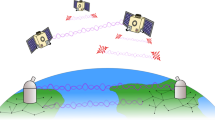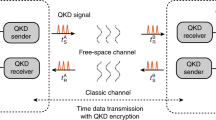Abstract
The recent rapid growth of satellite-constellation programmes for remote sensing and communications, enabled by the availability of small-sized and low-cost satellites, has provided impetus for the development of high-capacity laser communication (lasercom) in space. Quantum-limited communication can enhance the performance of lasercom and is also a prerequisite for the intrinsically hack-proof secure communication known as quantum key distribution. Here, we report a quantum-limited communication experiment between a microsatellite (48 kg, 50 cm cube) in low Earth orbit and a ground station. Non-orthogonal polarization states were transmitted from the satellite at a 10 MHz repetition rate. On the ground, by post-processing the received quantum states with ∼0.146 photons per pulse, clock data recovery and polarization reference-frame synchronization were successfully achieved, even under remarkable Doppler shifts. The quantum states were discriminated by a receiver with four photon counters, with a quantum bit error rate below 5%, validating the applicability of our technology to satellite-to-ground lasercom and quantum key distribution.
This is a preview of subscription content, access via your institution
Access options
Access Nature and 54 other Nature Portfolio journals
Get Nature+, our best-value online-access subscription
$29.99 / 30 days
cancel any time
Subscribe to this journal
Receive 12 print issues and online access
$209.00 per year
only $17.42 per issue
Buy this article
- Purchase on Springer Link
- Instant access to full article PDF
Prices may be subject to local taxes which are calculated during checkout
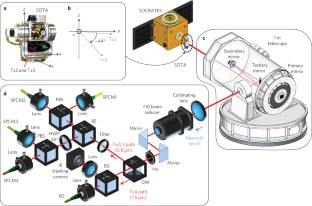
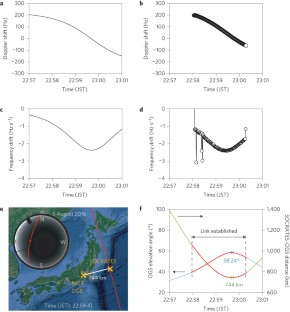
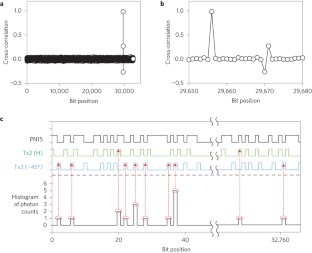

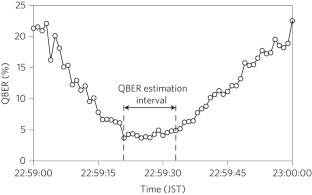
Similar content being viewed by others
References
Chan, V. W. S. Optical satellite networks. J. Lightw. Technol. 21, 2811–2827 (2003).
Toyoshima, M. Trends in satellite communications and the role of optical free-space communications [Invited]. J. Opt. Netw. 4, 300–311 (2005).
Arimoto, Y. et al. Laser communication experiment using ETS-VI satellite. J. Commun. Res. Lab. 42, 285–292 (1995).
Jono, T. et al. OICETS on-orbit laser communication experiments. Proc. SPIE 6105, 610503 (2006).
Toyoshima, M. et al. Results of Kirari optical communication demonstration experiments with NICT optical ground station (KODEN) aiming for future classical and quantum communications in space. Acta Astronaut. 74, 40–49 (2012).
Sodnik, Z., Furch, B. & Lutz, H. Free-space laser communication activities in Europe: SILEX and beyond. In LEOS 2006–19th Annual Meeting IEEE Lasers and Electro-Optics Soc. 78–79 (IEEE, 2006).
Smutny, B. et al. 5.6 Gbps optical intersatellite communication link. Proc. SPIE 7199, 719906 (2009).
Boroson, D. M. Overview of the lunar laser communication demonstration. In Proc. Int. Conf. Space Optical Systems Applications S1–2 (ICSOS, 2014).
Samain, E. et al. First free space optical communication in Europe between SOTA and MeO optical ground station. In Proc. IEEE Int. Conf. Space Optical Systems Applications 1–7 (IEEE, 2015).
Petit, C. et al. Investigation on adaptive optics performance from propagation channel characterization with the small optical transponder. Opt. Eng. 55, 111611 (2016).
Carrasco-Casado, A. et al. LEO-to-ground polarization measurements aiming for space QKD using Small Optical TrAnsponder (SOTA). Opt. Express 24, 12254–12266 (2016).
Bennett, C. H. & Brassard, G. Quantum cryptography: public key distribution and coin tossing. In Proc. IEEE Int. Conf. Computers, Systems, and Signal Processing 175–179 (IEEE, 1984).
Hughes, R. J., Nordholt, J. E., Derkacs, D. & Peterson, C. G. Practical free-space quantum key distribution over 10 km in daylight and at night. New J. Phys. 4, 43.1–43.14 (2002).
Ursin, R. et al. Entanglement-based quantum communication over 144 km. Nat. Phys. 3, 481–486 (2007).
Schmitt-Manderbach, T. et al. Experimental demonstration of free-space decoy-state quantum key distribution over 144 km. Phys. Rev. Lett. 98, 010504 (2007).
Wang, J.-Y. et al. Direct and full-scale experimental verifications towards ground–satellite quantum key distribution. Nat. Photon. 7, 387–393 (2013).
Nauerth, S. et al. Air-to-ground quantum communication. Nat. Photon. 7, 382–386 (2013).
Villoresi, P. et al. Experimental verification of the feasibility of a quantum channel between space and Earth. New J. Phys. 10, 033038 (2008).
Yin, J. et al. Experimental quasi-single-photon transmission from satellite to earth. Opt. Express 21, 20032–20040 (2013).
Bedington, R. et al. Nanosatellite experiments to enable future space-based QKD mission. EPJ Quantum Technol. 3, 12 (2016).
Günthner, K. et al. Quantum-limited measurements of optical signals from a geostationary satellite. Optica 4, 611–616 (2017).
Gibney, E. Chinese satellite is one giant step for the quantum internet. Nature 535, 478–479 (2016).
Bennett, C. H. Quantum cryptography using any two nonorthogonal states. Phys. Rev. Lett. 68, 3121–3124 (1992).
Tittel, W., Brendel, J., Zbinden, H. & Gisin, N. Quantum cryptography using entangled photons in energy-time Bell states. Phys. Rev. Lett. 84, 4737–4740 (2000).
Huang, H. et al. 100 Tbit/s free-space data link enabled by three-dimensional multiplexing of orbital angular momentum, polarization, and wavelength. Opt. Lett. 39, 197–200 (2014).
Winker, D. M., Hunt, W. H. & McGill, M. J. Initial performance assessment of CALIOP. Geophys. Res. Lett. 34, L19803 (2007).
Nordholt, J. E., Hughes, R. J., Morgan, G. L., Peterson, C. G. & Wipf, C. C. Present and future free-space quantum key distribution. Proc. SPIE 4635, 116–126 (2002).
Sasaki, M. et al. Quantum photonic network: concept, basic tools, and future issues. IEEE J. Sel. Top. Quantum Electron. 21, 49–61 (2015).
Endo, H. et al. Free-space optical channel estimation for physical layer security. Opt. Express 24, 8940–8955 (2016).
Acknowledgements
The authors thank M. Akioka, T. Kubooka and H. Endo for their technical support on SOCRATES operation and data analysis. This work was supported in part by the ImPACT (Impulsing PAradigm change through disruptive Technologies) Program of the Cabinet Office of Japan.
Author information
Authors and Affiliations
Contributions
M.T., H.T., M.F. and M.S. conceived and designed the experiments. H.T., M.K. and M.F. performed the experiments. H.T., A.C.-C., M.K. and M.F. analysed the data. M.S. and A.C.-C. wrote the paper with discussions and input from all authors. M.T. and M.S. supervised the experiments.
Corresponding author
Ethics declarations
Competing interests
The authors declare no competing financial interests.
Supplementary information
Supplementary information
Supplementary information (PDF 1031 kb)
Supplementary information
Supplementary information (MP4 6878 kb)
Rights and permissions
About this article
Cite this article
Takenaka, H., Carrasco-Casado, A., Fujiwara, M. et al. Satellite-to-ground quantum-limited communication using a 50-kg-class microsatellite. Nature Photon 11, 502–508 (2017). https://doi.org/10.1038/nphoton.2017.107
Received:
Accepted:
Published:
Issue Date:
DOI: https://doi.org/10.1038/nphoton.2017.107
This article is cited by
-
Satellite-based quantum information networks: use cases, architecture, and roadmap
Communications Physics (2023)
-
A probabilistic model of quantum states for classical data security
Frontiers of Physics (2023)
-
Statistical verifications and deep-learning predictions for satellite-to-ground quantum atmospheric channels
Communications Physics (2022)
-
Quantum mechanical rotation of a photon polarization by Earth’s gravitational field
npj Quantum Information (2021)
-
Spooky action at a global distance: analysis of space-based entanglement distribution for the quantum internet
npj Quantum Information (2021)

